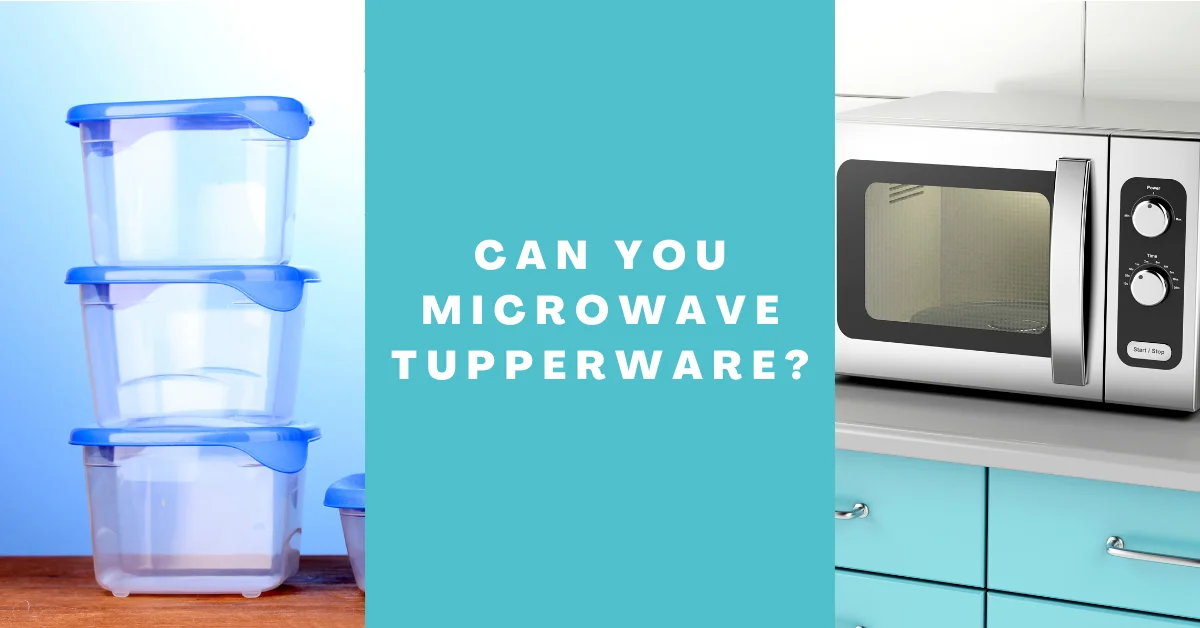Got leftovers? Save them in Tupperware containers instead of Ziplock bags to make the reheating and defrosting process easy. Tupperware microwave containers are lifesavers when it comes to saving and reheating leftovers. So, if you’re always in a rush, Tupperware containers may become your best friend.
Yes! You can microwave Tupperware. It is a popular way to store and serve food; however, not all Tupperware is safe. You can only microwave what has been labeled for microwave use.
If you are wary of microwaving food in plastic containers, rightly so, worry not. I’m here to help detail both the pros and cons of using Tupperware and inform you of all hazards. Read on to know more.
Can you microwave Tupperware?
It is always better to use glass or ceramic utensils to microwave your food. Plastic containers may contain BPA, which is bad for your health. However, Tupperware is a good alternative as long as it is microwave-safe. It is not only easy to care for relative to glass and ceramic containers but is also more durable.
You can use Tupperware to heat food in the microwave as long as it is labeled as microwave-safe. Using microwave-safe Tupperware can heat your food without directly impacting it in terms of harmful chemicals.
However, suppose you are still wary of using Tupperware to heat your food in the microwave. In that case, you can opt to transfer the food to a glass or ceramic container. These are relatively safer options health-wise since both these materials are non-reactive.
How to tell if your Tupperware is microwave-safe?
Food storage containers made of plastic are usually very tricky when figuring out whether they are safe. To help ease your mind, most of these plastic containers, including Tupperware, come with safety information regarding whether they are microwave-safe, dishwasher-safe, freezer-safe, etc. The key here is to be able to decipher these symbols for what they are.
You can identify microwave-safe Tupperware by the symbol of the squiggly line. There can be many variations; however, squiggly lines are a universal symbol, and as long as they are present, you can heat them in a microwave without worry.
Most times, you will be able to find the label “Microwave Safe” on Tupperware. Other symbols can also be used to label Tupperware as microwave-safe, such as the presence of simply a microwave image beneath your container. Sometimes a symbol can be modified even further, like an image of a dish set below radiation waves.
Therefore look for squiggly lines when you need to be sure whether the Tupperware is microwave-safe. If you find labels and symbols that you can’t decipher, it is always better to check the manufacturer’s website to make sense of them.
How to Reheat food in Tupperware microwave Containers?
Now that you know whether it is safe to heat food in the microwave using Tupperware containers and how to ensure that we are using microwave-safe containers, the next step is to know how to reheat food properly and safely. Using proper etiquette while using Tupperware will help reduce the chances of staining and damage, thus increasing the product’s durability.
The proper heating procedure helps increase Tupperware’s durability and minimizes any health hazards such as stirring the product frequently will help minimize chances of staining the container. You should break up frozen portions, which reduces the time spent boiling against plastic.
Important tips for reheating food in Tupperware
To make things easier, we have listed down all-important tips you may need while reheating your food in Tupperware microwave Containers. To ensure that your food and container quality doesn’t deteriorate, you should follow these tips to the last detail.
- Your food might come in contact with bacteria in more ways than one; hence it is important that when you reheat your food, make sure you reach a maximum temperature of 165°F. This will help in ensuring that most of the bacteria has been killed as it can’t withstand high temperatures.
- Food can be refrigerated using microwave-safe Tupperware; however, to keep your container from warping or breaking, avoid freezing food in the same container. It is better to use freezer-safe Tupperware for freezing food.
- Microwaves usually create cool and hot spots inside your food which may ultimately lead to microbial contamination. You must make sure to stir while reheating your food in Tupperware microwave Containers as it will help avoid staining and help keep away from contamination.
- It is always a safer option to only reheat the required portion of food. This is true especially when it comes to fatty foods like cheese, meat, and even products like soup because they easily reach very high temperatures that may end up damaging your Tupperware.
- If you are reheating any frozen food products, you should keep in mind to always break the frozen portions to encourage an even movement of heat throughout the entire dish. This tip will also help reduce the time your food spends boiling or heating directly against the plastic, which is a safer option.
- It is essential to always check the bottom of a container to make sure it is microwave-safe since not all Tupperware containers are microwave-safe. Better safe than sorry. Therefore always double-check before reheating your food.
- Never reheat food in Tupperware containers without the lid as direct exposure from the microwave may make the food chewy, and beady, and may also dry up any broth.
- Therefore, to avoid the hassle of lids and chewy food, it is better to invest in Tupperware containers that comprise a vent. The vent will help the pressure escape from the container more gently. If your container doesn’t have a vent, you can lift the container’s edges, which will give the same effect as the vent.
- It is always better to read the instructions that come with each container and follow through with them. This will make things a lot easier for you and help avoid any hazards.
Most Tupperware containers always come with a warranty that lasts a lifetime. However, following the above-given tips will help you make the right use of a lifetime warranty.
Why use Tupperware microwave Containers?
The most harmful ways of storing and reheating food are using Ziploc bags and takeaway containers from restaurants. Investing in Tupperware microwave containers is always a safer and more economical option.
Plastic containers relative to ceramics and glass are convenient because they are break-proof, lightweight, cheap, and easier to care for. They also come in handy for vanity purposes as they are available in various styles and colors.
Even though glass and ceramic are non-reactive compared to plastic, they’re still heavy, dangerous if broken, and relatively more expensive. Tupperware microwave containers are the best alternative because of their durability and convenience in usage.
Final thoughts on whether you can microwave Tupperware!
Our food comes in contact with plastic on a daily basis, whether directly or indirectly. Plus more often than not, we pay little mind to which plastic is safe to hold and heat our food. It’s a smart decision to invest in Tupperware containers as they make the process of reheating and storing food easier. It will take a huge burden off your chest by ensuring safety when mixing plastic with heat.



